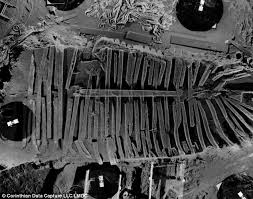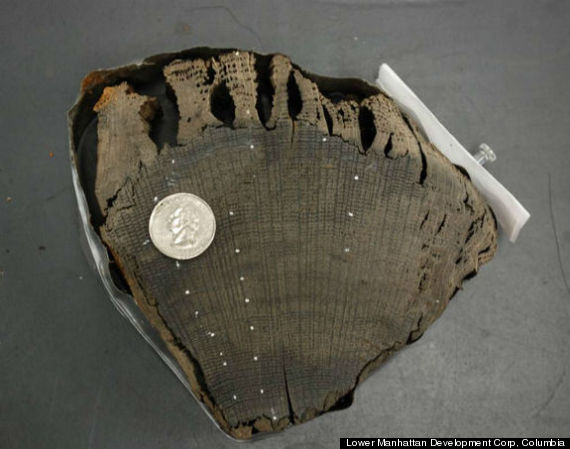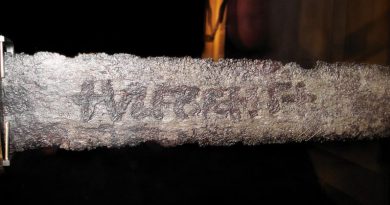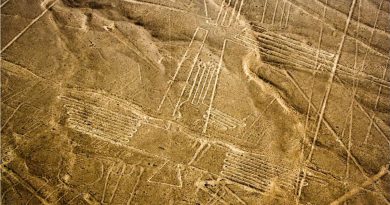Mystery of Ancient ship unearthed at World Trade Center site
In 2010, excavators in New York’s Lower Manhattan discovered buried deep in the ground the remains of a wooden ship and—according to a new study—that ship was built using timber that had been harvested from old-growth forests in southeastern Pennsylvania around 1773.
Independence Hall and other Revolutionary-era buildings in Philadelphia were constructed using timber harvested around the same time and from the same area, according to Edward Cook, a tree ring scientist at Columbia University in New York and the senior author of the study, which was published in the July issue of the journal Tree-Ring Research.
On the morning of July 13, 2010, the roar of backhoes and bulldozers echoed through lower Manhattan as construction continued on the rebirth of the World Trade Center site, which had been destroyed nearly nine years earlier in the worst terrorist attack in American history. Molly McDonald and her fellow archaeologists from consulting firm AKRF had arrived early that morning to a parcel between Liberty and Cedar Streets to document the remains of timber wharves unearthed during excavation work for a planned underground parking complex. More than 20 feet below street level on what was once the bottom of the Hudson River, McDonald suddenly spotted a hewn, curved piece of timber sticking out of the thick black mud that was quite different from the planks used to build wharves. She knew immediately what had been discovered—the remains of a ship.

Construction stopped as archaeologists began the careful process of digging. Although the work was painstaking, time was also of the essence, not just to make sure construction continued on schedule, but also to ensure the relic’s preservation. To protect the wooden ship from damage, workers blocked the searing summer sun by hoisting a gray tarp over the site, and they regularly hosed down the timbers to prevent them from drying out, which would cause warping and splitting. By the third day, the full outline of the 32-foot-long partial hull from the rear of the ship could clearly be seen. It took two weeks to complete the labor-intensive task of cleaning, cataloging and excavating the fragile timber pieces before they were shipped to the Maryland Archaeological Conservation Laboratory for preservation.
With the ship’s skeleton finally removed from the construction site, work then began to solve the mystery. What were the origins of this ship and how did it end up below the World Trade Center site? According to a new study published in the July 2014 edition of the journal Tree-Ring Research, scientists believe they have the answer, and the key to solving the mystery was buried with the ship itself.
After uncovering the ship, scientists quickly determined that its frame had been constructed of white oak. Since white oak is common all over the world, however, the identification offered little help in identifying the ship’s origins. The discovery of hickory in the keel, however, proved to be the big breakthrough. Hickory trees are found only in eastern areas of Asia and the United States, and given that the ship was highly unlikely to have come from Asia, scientists focused their investigation on American origins.

With the geographic focus narrowed, the investigation turned to dendrochronology—the science of dating artifacts by analyzing tree-ring patterns. Since trees add tighter rings in dry years and wider rings in wet years, they carry unique fingerprints of the particular climates and times in which they live. By examining slices of the ship’s timber and comparing them to other archaeological samples, tree-ring scientists from Columbia University’s Lamont-Doherty Earth Observatory in Palisades, New York, found that the well-defined ring patterns in the white oak used to build the vessel actually matched wooden samples they had taken in the late 1980s from Philadelphia’s Independence Hall, the historic landmark where the Founding Fathers signed both the Declaration of Independence and the U.S. Constitution. The ship’s timber matched a dense, old-growth forest near Philadelphia, and the dendrochronologists determined that the white oaks used to build it were felled in 1773.
Scientists identified the vessel as a Hudson River Sloop—a boat type designed by Dutch settlers to transport passengers and cargo in shallow, rocky waters—that was likely built in a small shipyard near Philadelphia. Small holes discovered in the ship’s frame likely resulted from shipworms native to the salty, warm waters of the Caribbean, which means the vessel was likely among the commercial flotilla engaged in the Colonial triangle trade, transporting rum and sugar along the Atlantic seaboard.
How did the Philadelphia-constructed ship end up below ground in lower Manhattan? Two centuries ago, the site of the World Trade Center would have been in the Hudson River. But as Manhattan prospered after the American Revolution, land on the lower part of the island became scarce, so New Yorkers began to create land by filling the river with garbage, rock, scrap wood and other fill material that sometimes included the hulks of ships that were no longer seaworthy. The area around the World Trade Center was built on this extended shoreline, and the shipworm damage found on the unearthed vessel suggest it was a prime candidate to have been used in Manhattan’s westward expansion. Since the location where the ship was found was not part of the original World Trade Center site, it remained undisturbed for two centuries below the ground.
The study’s authors note that since few 18th-century ships have been discovered and little historical documentation about their construction exists, “the hull encountered at the World Trade Center represents a rare and valuable piece of American shipbuilding history.” The ship’s timbers now reside at the Center for Maritime Archaeology & Conservation at Texas A&M University. It’s possible that the timbers will be reassembled in the future, but no plans have been announced.
Source:History.com



